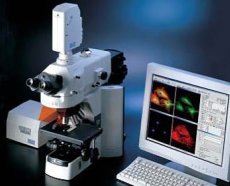Nikon Digital Microscopes
- Eclipse 80i and 90i Models -
In staying current, Nikon digital microscopes offer the technology to digitally capture specimen details in one amazing imaging system.
Nikon is strong in the digital camera market and their camera models can be incorporated onto microscope eyepieces with the help of a digital microscope camera adapter. However, what hobbyists and professional microscopists want and need is a built in digital imaging system as part of a a quality microscope.
Digital technology is a mainstream requirement in microscopy and Nikon offers certain microscope products in order to properly cater to this growing demand.
MicroscopeMaster reviews these models below with more to be added soon.
The Nikon Eclipse 80i microscope
The Nikon Eclipse 80i is one of Nikons digital microscopes offering amazing capabilities.

Nikon 80i Microscope featured at SEOEnterprises.com
The 80i has a bright illumination system with a 12v-100w halogen lamp and “fly-eye” to enhance digital image lighting.
It also comes with a noise terminator, which directs stray light away from the light-collection path, increasing image contrast and clarity.
Other elements unique to this model include:
- excitation balancer, for use with multi stained specimens
- 6-filter turret
- all-in-one digital imaging unit
- alumite stage, creating a hard, smooth enduring surface
- auto-detection
The Eclipse 80i, with its many advanced and powerful features, can be applied in an array of settings, including clinical, industrial and educational, and science fields such as histology, microbiology, genetics, cytology and the like.
The Nikon Eclipse 90i microscope
Introduced in 2004, the Nikon Eclipse 90i is the top of the line of Nikon digital microscopes.
 Nikon 90i Microscope featured
Nikon 90i Microscope featuredat micron-optics.com
A mating of advanced digital technology with precision optics, this instrument meets the most stringent requirements of medical research, biochemistry, genomics, pathology, and biological research.
This fully automated microscopy system allows scientists to expend efforts on his/her research and not on manually adjusting the microscope.
Key features of the Eclipse 90i are:
- Fly-Eye lens
- Plan Apo VC Objectives -- helps create multidimensional, ultra-high resolution images by improving axial chromatic corrections to the periphery of viewing field and expanding the spectral correction into the violet range
- Easy Access Controls for light distribution, nosepiece rotation, focusing, light intensity, filters and aperture
- High-precision focus, in increments of 50 nanometers
- Computer Control via iControl software, including auto-switching of observation techniques preferences stored on a PC
- NIS Elements Digital Imaging Software
- Capture of Auto-focus Images
Of all of the Nikon microscopes, the 90i boasts of the most advanced digital imaging head.
This motorized head uses two different types of digital imaging and allows data such as filters, analyzer position, optical path and magnification settings of large quantities of images to be saved with the digital image.
The Hi S/N epi-fluorescence illuminator, binocular tube, dual ports, and optical zoom are engineered into a single unit for greater control, yielding higher contrast fluorescence images.
In addition, a noise terminator eliminates extraneous light in fluorescent images.
Dual camera ports allow for the simultaneous mounting of two different cameras; a 0.8X–2.0X optical zoom located on the rear camera port allows images to be captured in high-definition.
The hallmark of this microscope is its ability to automatically perform many tasks the user would otherwise manually perform.
A selection of accessories including a PC control unit, standalone control unit and various camera heads are available.
The only downside to this instrument is a rather hefty price.
Understanding the technological advancements of the digital microscope can help to gain recognition for your work and accomplishments in the microscopy field through the ease at which the "world" can now interactively view your research and discoveries.
If digital imaging is a necessity in your research and study then Nikon digital microscopes - the 80i and 90i should be on your consideration list. Nikon has always been fair and competitive with great interchangeability.
Users are satisfied and MicroscopeMaster is sure you will be too.
Return from Nikon Digital Microscopes to Nikon Microscope Reviews
Return from Nikon Digital Microscopes to Best Microscope Reviews Home
Find out how to advertise on MicroscopeMaster!




